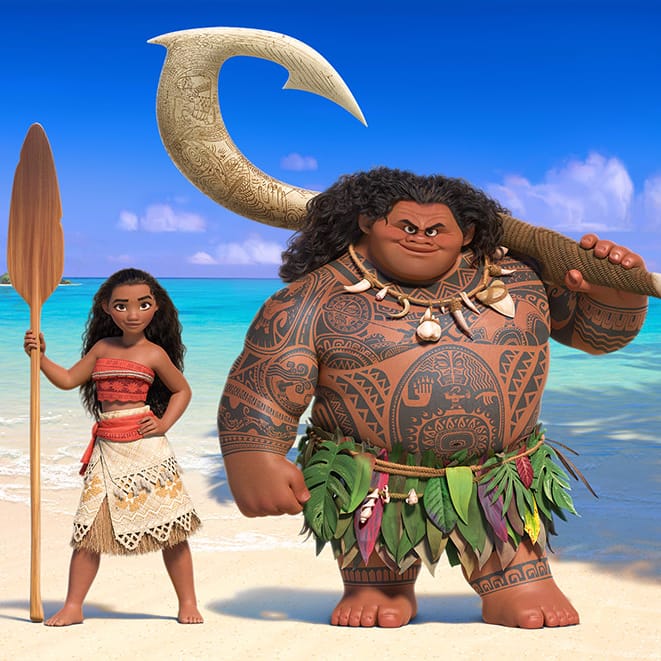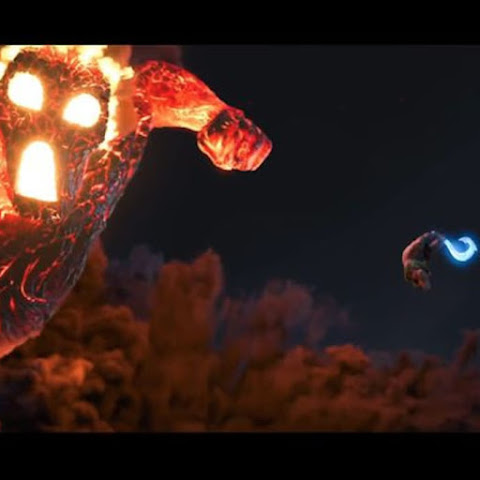'Moana' Is One of Disney's Best Movies Yet
The innovative new film uses tattoos to tell its story.
Disney's Moana is an enjoyable and entertaining film that everyone should see, despite its shortcomings in terms of cultural representation. Moana is the first Disney film to feature characters from the South Pacific and while the creators put an enormous amount of effort into getting things right, they fell a little bit short of the mark in a few instances.
However, it is the inclusion of a fascinating culture that makes Moana stand out. When compared to the company's other recent success, Frozen, it totally puts it to shame. While the production values for each of these movies are on par, the narrative and cultural representation in Moana makes for a more engaging and compelling example of animation, not to mention most of the musical numbers are just catchier. One of the best parts of the movie, however, is the way that tattoos play a very important part in its storytelling.
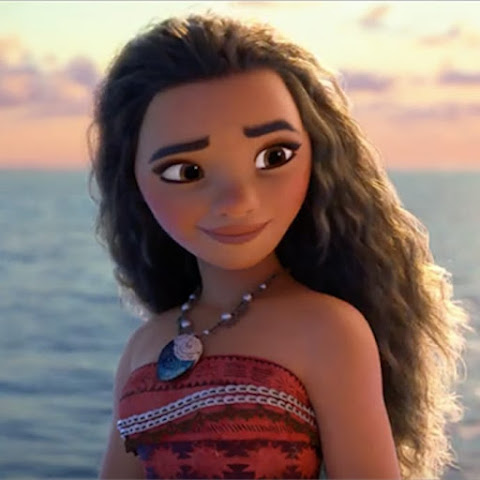
A shot of the heroine from Disney's Moana.
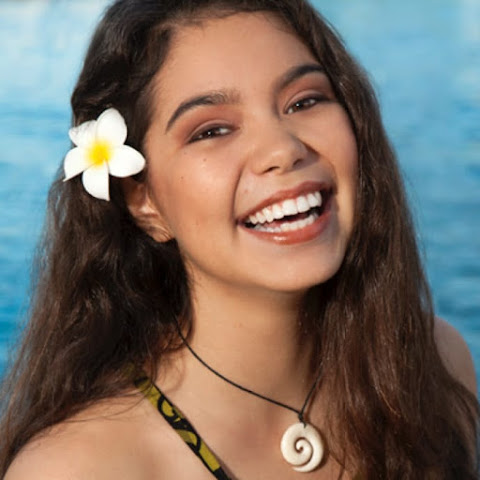
Auli’i Cravalho, the actress who voices Moana in Disney's new movie.
The film's protagonist, Moana, is voiced by Auli’i Cravalho — a young Hawaiian actress — and her performance is a large part of what makes the movie such a success. Her familiarity with island culture lends authenticity to the film. It's amazing how she transforms a script largely shaped by white males — directors Ron Clements and John Musker — into such a believable as well as relatable character. Alongside the credibility that Cravalho's performance brings to the movie, the company did something rather unprecedented that made Moana stand out from its disastrous depictions of indigenous peoples in the past, the train wreck of cultural representation that is Pocahontas at the forefront of them.
Beyond making the right decisions in terms of casting, the company also did their research to try to get things right, even though they may have missed the mark here and there. Chief Creative Officer of Walt Disney Animation, John Lasseter, encouraged the directors to actually visit the South Pacific to learn about cultures there. This initiative lead to what was dubbed Oceanic Story Trust — a team of anthropologists, historians, linguists, and other experts who served as cultural advisors for the film. The positive results of this effort are apparent. You can see it in everything from how the characters talk to how they move and what they wear.
Aside from all the things that Disney got right, the biggest disappointment was the main character's demigod companion — Māui. It's difficult to dislike anything that Dwayne "The Rock" Johnson does, especially when he's playing a character that's covered in tattoos, but the writing behind this mythological figure is just flawed. Māui, who goes by many names throughout this region of the world, is generally thought of as freedom fighter — a hero who embodies principles of equality. Disney's version, however, is somewhat of a caricature, not only in his exaggerated physical appearance but in his braggadocios attitude as well. Simply put, the main problem is that the directors constructed a figure who is representative of western values like individualism as opposed to what he actually means to the culture that they were "trying" to do justice to.

Moana singing the musical number "How Far I'll Go" from Disney's new film.
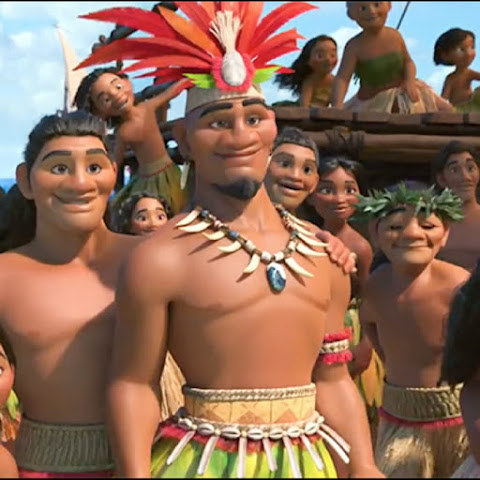
A shot of Moana's ancestors from the song "We Know the Way" in Disney's new movie.
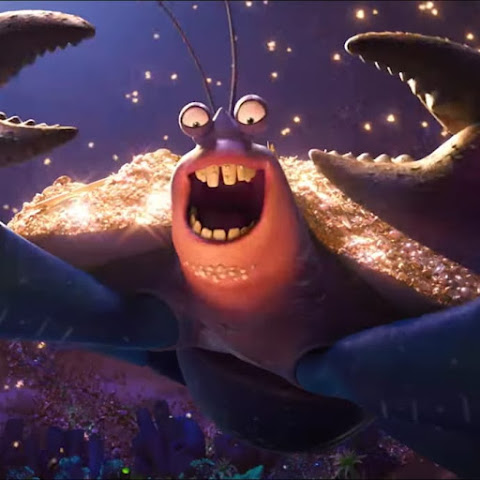
Tamatoa, the very shiny giant crab from Disney's Moana.
Conversely, the music in Moana is another one of its saving graces. Combined with the wonderful animation, some of the numbers are absolutely tearjerking while others are brimming with joy. The soundtrack is simply amazing. Like, right up there with The Lion King excellent. Disney brought together an all-star team to make this happen. The songs are written by Lin-Manuel Miranda (of Hamilton fame), Mark Mancina — who also composed the score — and Opetaia Foa'i, a member of the band Te Vaka. While most of the lyrics are written in English, some of the best songs even incorporate the Tokelauan language. When you see the film, keep an ear open for the tracks "How Far I'll Go," "We Know the Way," "You're Welcome," and "Shiny" — which features Jermaine Clement doing a David Bowiesque number as a giant crab known as Tamatoa.
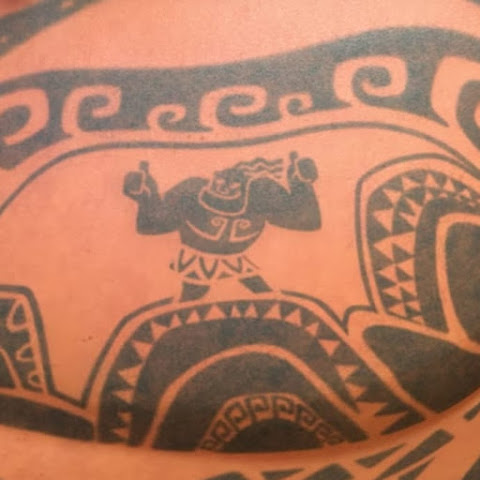
A closeup of mini-Māui, the animated tattoo version of Māui on his body from Disney's Moana.
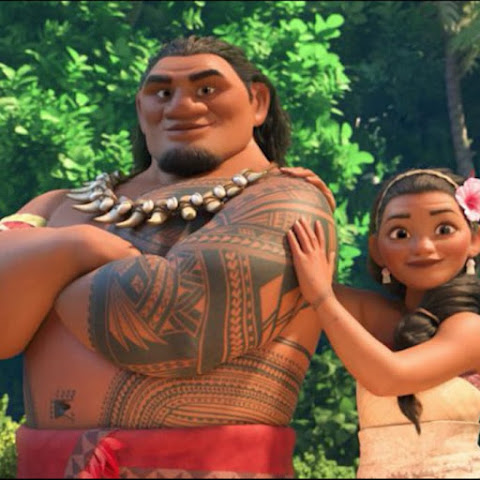
Chief Tui and Sina, Moana's father and mother, in Disney's new film.
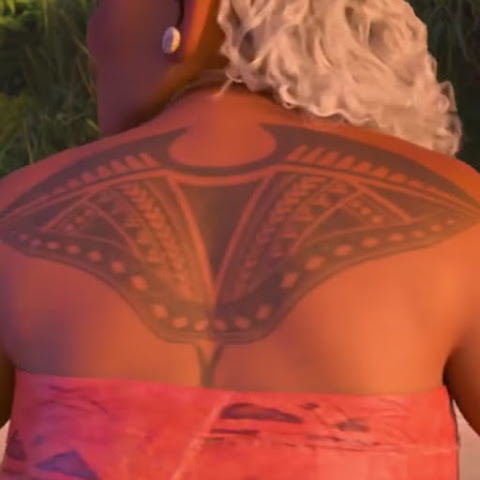
Gramma Tala's tattoo of a stingray in Disney's Moana.
One of the aspects of Moana that makes it unique when compared to other Disney films is that tattoos serve as a means of storytelling throughout the film. Several of the primary characters feature traditional Maori body art, including Moana's father, Chief Tui, and her grandmother, Tala, whose tattoo of a stingray has an incredibly moving element of symbolism to it within the plot. It's Māui's tattoos that steal the show though. Similarly to the muses on Grecian urns in Hercules, his bodily markings are animated. His tattoos represent creation myths that the film accurately attributes to his legendary figure, like raising up the vault of the sky or pulling the sun closer to the earth with his magic fish hook. There is also a tiny version of him in every one of the mythological scenes on his body. This miniature Māui acts as a sort of conscience for his otherwise self-interested character, prompting him to help Moana when his big ego gets in the way.
The way that Māui's and other characters' body art operates within the storyline is fascinating because it reflects how traditional Maori tattoos are representative of their peoples' heritage. Though body art doesn't move in real life, it does have the power to tell stories, and this is one of its most important functions within indigenous communities. For these individuals, tattoos are more than bodily ornamentation; they are inscriptions that represent ties to their community and the past, and in short, Disney exemplifies this fact in its own clever way.
All in all, Moana represents a new chapter in Disney's approach to sensitive subject matter. Perhaps, the advent of this splendid film signifies that the days of egregious cultural appropriation in mainstream animated cinema are in decline. If they keep making movies like this, Moana could mark the beginning of a second and more progressive Disney Renaissance, but only time will tell. So, if you love compelling storytelling, breathtaking visuals, and thrilling musical numbers, go check out the movie for yourself. It's more than worth the price of ticket.
However, it is the inclusion of a fascinating culture that makes Moana stand out. When compared to the company's other recent success, Frozen, it totally puts it to shame. While the production values for each of these movies are on par, the narrative and cultural representation in Moana makes for a more engaging and compelling example of animation, not to mention most of the musical numbers are just catchier. One of the best parts of the movie, however, is the way that tattoos play a very important part in its storytelling.

A shot of the heroine from Disney's Moana.

Auli’i Cravalho, the actress who voices Moana in Disney's new movie.
The film's protagonist, Moana, is voiced by Auli’i Cravalho — a young Hawaiian actress — and her performance is a large part of what makes the movie such a success. Her familiarity with island culture lends authenticity to the film. It's amazing how she transforms a script largely shaped by white males — directors Ron Clements and John Musker — into such a believable as well as relatable character. Alongside the credibility that Cravalho's performance brings to the movie, the company did something rather unprecedented that made Moana stand out from its disastrous depictions of indigenous peoples in the past, the train wreck of cultural representation that is Pocahontas at the forefront of them.
Beyond making the right decisions in terms of casting, the company also did their research to try to get things right, even though they may have missed the mark here and there. Chief Creative Officer of Walt Disney Animation, John Lasseter, encouraged the directors to actually visit the South Pacific to learn about cultures there. This initiative lead to what was dubbed Oceanic Story Trust — a team of anthropologists, historians, linguists, and other experts who served as cultural advisors for the film. The positive results of this effort are apparent. You can see it in everything from how the characters talk to how they move and what they wear.
Aside from all the things that Disney got right, the biggest disappointment was the main character's demigod companion — Māui. It's difficult to dislike anything that Dwayne "The Rock" Johnson does, especially when he's playing a character that's covered in tattoos, but the writing behind this mythological figure is just flawed. Māui, who goes by many names throughout this region of the world, is generally thought of as freedom fighter — a hero who embodies principles of equality. Disney's version, however, is somewhat of a caricature, not only in his exaggerated physical appearance but in his braggadocios attitude as well. Simply put, the main problem is that the directors constructed a figure who is representative of western values like individualism as opposed to what he actually means to the culture that they were "trying" to do justice to.

Moana singing the musical number "How Far I'll Go" from Disney's new film.

A shot of Moana's ancestors from the song "We Know the Way" in Disney's new movie.

Tamatoa, the very shiny giant crab from Disney's Moana.
Conversely, the music in Moana is another one of its saving graces. Combined with the wonderful animation, some of the numbers are absolutely tearjerking while others are brimming with joy. The soundtrack is simply amazing. Like, right up there with The Lion King excellent. Disney brought together an all-star team to make this happen. The songs are written by Lin-Manuel Miranda (of Hamilton fame), Mark Mancina — who also composed the score — and Opetaia Foa'i, a member of the band Te Vaka. While most of the lyrics are written in English, some of the best songs even incorporate the Tokelauan language. When you see the film, keep an ear open for the tracks "How Far I'll Go," "We Know the Way," "You're Welcome," and "Shiny" — which features Jermaine Clement doing a David Bowiesque number as a giant crab known as Tamatoa.

A closeup of mini-Māui, the animated tattoo version of Māui on his body from Disney's Moana.

Chief Tui and Sina, Moana's father and mother, in Disney's new film.

Gramma Tala's tattoo of a stingray in Disney's Moana.
One of the aspects of Moana that makes it unique when compared to other Disney films is that tattoos serve as a means of storytelling throughout the film. Several of the primary characters feature traditional Maori body art, including Moana's father, Chief Tui, and her grandmother, Tala, whose tattoo of a stingray has an incredibly moving element of symbolism to it within the plot. It's Māui's tattoos that steal the show though. Similarly to the muses on Grecian urns in Hercules, his bodily markings are animated. His tattoos represent creation myths that the film accurately attributes to his legendary figure, like raising up the vault of the sky or pulling the sun closer to the earth with his magic fish hook. There is also a tiny version of him in every one of the mythological scenes on his body. This miniature Māui acts as a sort of conscience for his otherwise self-interested character, prompting him to help Moana when his big ego gets in the way.
The way that Māui's and other characters' body art operates within the storyline is fascinating because it reflects how traditional Maori tattoos are representative of their peoples' heritage. Though body art doesn't move in real life, it does have the power to tell stories, and this is one of its most important functions within indigenous communities. For these individuals, tattoos are more than bodily ornamentation; they are inscriptions that represent ties to their community and the past, and in short, Disney exemplifies this fact in its own clever way.
All in all, Moana represents a new chapter in Disney's approach to sensitive subject matter. Perhaps, the advent of this splendid film signifies that the days of egregious cultural appropriation in mainstream animated cinema are in decline. If they keep making movies like this, Moana could mark the beginning of a second and more progressive Disney Renaissance, but only time will tell. So, if you love compelling storytelling, breathtaking visuals, and thrilling musical numbers, go check out the movie for yourself. It's more than worth the price of ticket.
